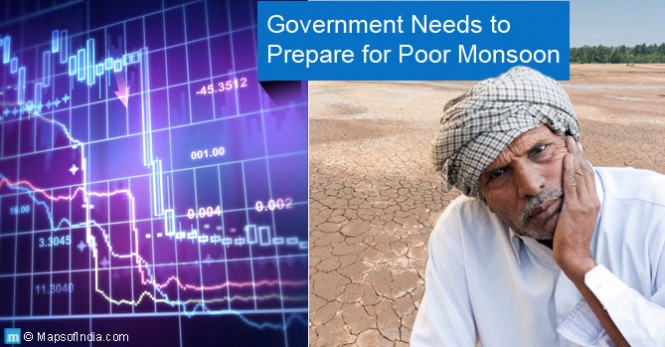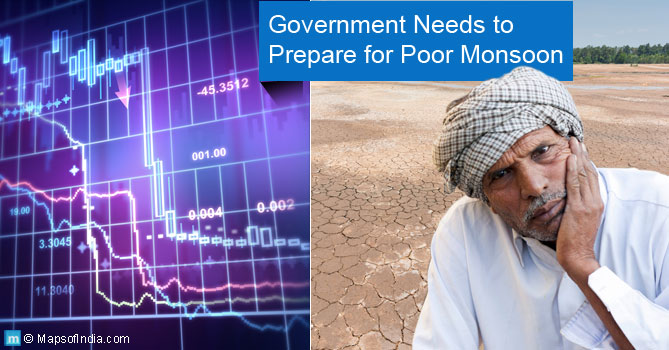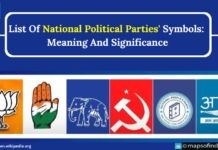 The Indian Meteorological Department (IMD) has predicted that the El Nino phenomenon will impact the weather pattern in India resulting in less than average monsoon rains this year. The news has left the government, along with all stakeholders including farmers, traders, retailers and stock market investors, worried. The early signs have not been very encouraging with the onset of monsoon over Kerala being delayed by 4-5 days.
The Indian Meteorological Department (IMD) has predicted that the El Nino phenomenon will impact the weather pattern in India resulting in less than average monsoon rains this year. The news has left the government, along with all stakeholders including farmers, traders, retailers and stock market investors, worried. The early signs have not been very encouraging with the onset of monsoon over Kerala being delayed by 4-5 days.
However, Skymet, a private weather pattern analysing and forecasting agency, has predicted a normal rainfall, despite El Nino. While the business of accurately predicting the weather has always been unpredictable and tricky, the government has little choice but to immediately begin to prepare for the worst.
Failure comes in different shades of grey
While the markets and most stakeholders tend to panic at the first sign of deficient monsoon, it must be understood that the impact of say a 3% to 5% shortfall in monsoon in Gujarat will be different from the impact over Central India or West Bengal, and therefore the level of response and the type of response has to be guided by local conditions and agricultural practices.
Certain parts of Vidarbha, Rayalseema and Telangana that have traditionally seen deficient rainfall, have also had to face the brunt of a pre-monsoon heat onslaught with several people already dead due to heat wave conditions. A 3-5 % drop in rainfall in these parts can have devastating consequences for the already stressed farmers of the region.
The question is, has the government learnt from past droughts and how well is the government prepared to tackle all possible situations this year?
So what is Government’s Plan B in case of monsoon failure?
The government is preparing to activate its contingency plans for drought relief to farmers, which involves providing immediate financial relief, making available appropriate drought-resistant seeds for alternate crops which require minimum water, and ensuring adequate availability of fodder for cattle in the targeted 580 districts in the country.
The government is planning to offer alternate crop variety seeds in case the monsoon is delayed by 2-3 weeks and has a different range of seeds for situations where the monsoon is delayed by 5-6 weeks.
The Challenges and Solutions
There is a wide gap between a contingency plan on paper and its implementation on the ground. Past experience in handling of drought response measures have shown that the response is usually not fast enough and very often not adequate enough, both of which together result in the stressed farmer not receiving the necessary help and leading to the farmer taking his own life, as a last resort.
The government usually offers seeds for alternate crops that consume less water and are more drought resistant. While, the government takes advice from our agricultural scientists, who rightly suggest suitable alternate varieties in keeping with the level of deficient rainfall and soil suitability, the farmers usually do not adopt these measures and take their own independent decisions to plant alternate crops, based on market prices and demand, and in the process, open themselves up to further vagaries of monsoon. The government and the local farmer are usually not on the same page.
What is needed is a pro-active decision making body at the local level, which will involve the affected farmers. The local authorities must be in a position to decide and action-off relief measures based on local farmer needs and preference. Merely, suggesting alternate crops to farmers and then leaving them to take further action will only exacerbate an already volatile situation.
Beyond providing seeds for alternate crops, financial relief measures are the most important response to a farmer’s stressed condition. The problem lies in lack of transparent and fair assessment of damaged crops to arrive at a fair compensation. As a result, there is a wide discrepancy in claimed damages between farmers of the same area. Very often, local officials join hands with farmers in over estimating or in some cases under estimating the damage to crops and therefore there is a skewed claim pattern for crop damages from the same region. This results in leakages in financial relief measures, which ultimately result in genuine cases being denied financial compensation.
With satellite imagery available at the government level and now, drone technology too has also proved its usefulness in monitoring and mapping crops, these can provide a quick and fair assessment to the government, which in turn can speed up the compensation to farmers through direct cash transfer to the farmer’s Jan Dhan account.
One of the most important acts that the government can initiate is to launch a major irrigation development programme which will include building of water catchment and water conservation facilities. The government has not made adequate investments in developing irrigation facilities and a large segment of farmers still remain dependent on monsoons. Unless investment in the area picks up significantly, India will continue to face major agricultural uncertainties in the years ahead, especially with demand for food growing continuously.
Availability of fodder in case of monsoon deficiency or failure causes severe stress to the farmer as he depends on cattle to supplement his livelihood. In most cases, the lack of adequate fodder for the already undernourished cattle, leads to extensive loss of cattle life.
Must Read: Deficient Monsoon: How Does It Affect Indian Economy?
PM Modi’s biggest challenge yet could be tackling the economy in case of a poor monsoon
Most economic and political analysts are unanimous in agreeing that the first year of PM Modi was eased by falling commodity prices, especially crude oil, which helped in tackling high inflation, along with making capital available to deploy back into the economy. However, in case of a deficient monsoon or outright drought this year, the government is going to be really tested for its macro management of the economy and the resulting political fallout.
So far the government has had it relatively easy with the PM riding high on domestic and international approval but most analysts agree that the magic is waning and this year is going to be a tough challenge for the present government.
On one hand, the government has been criticised for going slow on reforms, while on the other, it has also faced flak in not making adequate investments to boost agriculture. Take the long overdue reform of Food Corporation of India (FCI). FCI has been facing severe funds shortage in maintaining the massive foodgrain buffer stock of around 42 million tonnes. Amongst the suggested reforms has been to reduce the size of this buffer and therefore the government had targeted to offload 15 million tonnes of foodgrain in FY’15. The government has managed to reduce stocks by just 4 million tonnes, leaving FCI with the financial challenge of maintaining the remaining stock.
The government now has a dilemma. A monsoon failure will result in a spike in inflation and this will force the government to import food stocks to keep inflation down. With international oil prices strengthening along with the US Dollar, the pressure on existing forex reserves will increase. All these will only make implementation of reforms like reduction in fertilizer subsidy and restructuring of FCI, even more politically difficult.
Today, RBI Governor Raghuram Rajan may sound overly cautious in reducing interest rates but with the uncertainty of monsoons looming large and coupled with rising oil prices, uncertainty in the Middle-East and the fact that the US Fed authorities may hike interest rates in Sept, later this year, all point to the long-term caution that must be exercised and Governor Rajan’s prudent approach now may well turn out to be a blessing, in case the monsoons are below expectations.
PM Modi’s reputation of handling emerging situations will be severely tested this year and only time will tell how he stands up in implementing ‘Plan B’ in case the monsoon falls below expectations. Any loss in popularity and support from the farmers will hit PM Modi’s political plans really hard.
Time to watch out for the rains!




